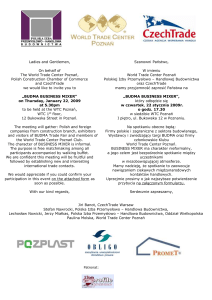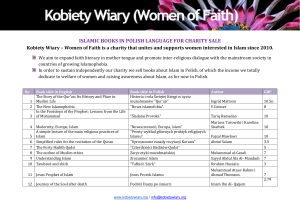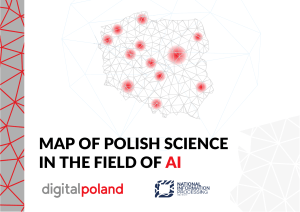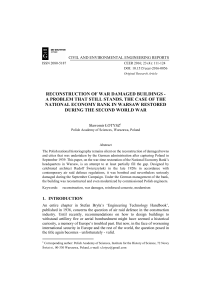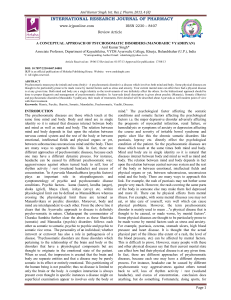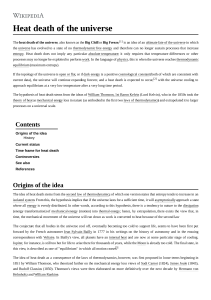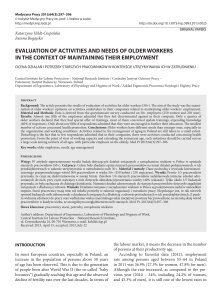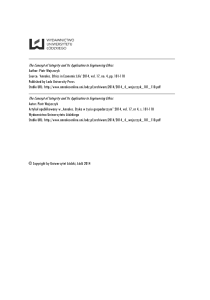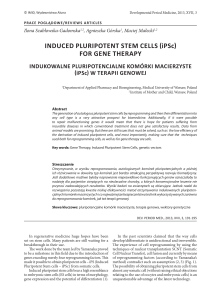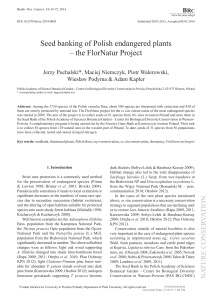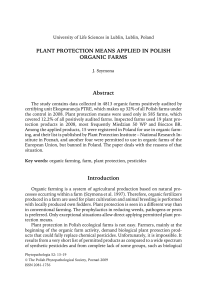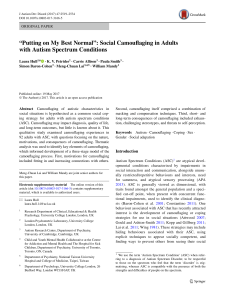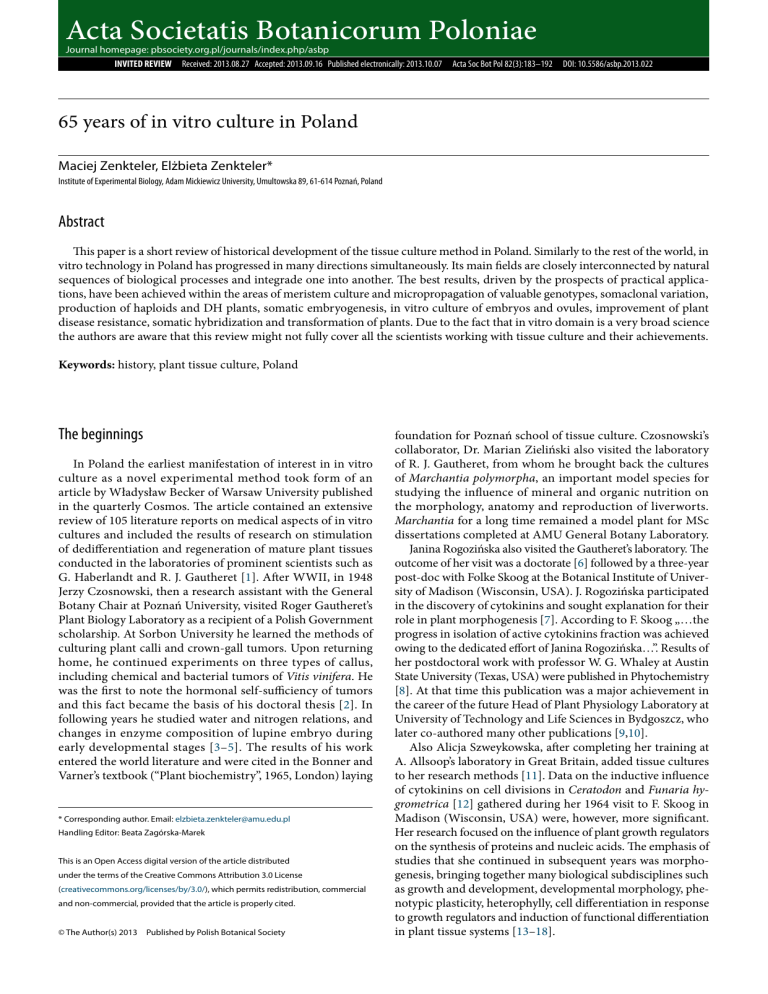
Acta Societatis Botanicorum Poloniae
Journal homepage: pbsociety.org.pl/journals/index.php/asbp
INVITED REVIEW Received: 2013.08.27 Accepted: 2013.09.16 Published electronically: 2013.10.07 Acta Soc Bot Pol 82(3):183–192 DOI: 10.5586/asbp.2013.022
65 years of in vitro culture in Poland
Maciej Zenkteler, Elżbieta Zenkteler*
Institute of Experimental Biology, Adam Mickiewicz University, Umultowska 89, 61-614 Poznań, Poland
Abstract
This paper is a short review of historical development of the tissue culture method in Poland. Similarly to the rest of the world, in
vitro technology in Poland has progressed in many directions simultaneously. Its main fields are closely interconnected by natural
sequences of biological processes and integrade one into another. The best results, driven by the prospects of practical applications, have been achieved within the areas of meristem culture and micropropagation of valuable genotypes, somaclonal variation,
production of haploids and DH plants, somatic embryogenesis, in vitro culture of embryos and ovules, improvement of plant
disease resistance, somatic hybridization and transformation of plants. Due to the fact that in vitro domain is a very broad science
the authors are aware that this review might not fully cover all the scientists working with tissue culture and their achievements.
Keywords: history, plant tissue culture, Poland
The beginnings
In Poland the earliest manifestation of interest in in vitro
culture as a novel experimental method took form of an
article by Władysław Becker of Warsaw University published
in the quarterly Cosmos. The article contained an extensive
review of 105 literature reports on medical aspects of in vitro
cultures and included the results of research on stimulation
of dedifferentiation and regeneration of mature plant tissues
conducted in the laboratories of prominent scientists such as
G. Haberlandt and R. J. Gautheret [1]. After WWII, in 1948
Jerzy Czosnowski, then a research assistant with the General
Botany Chair at Poznań University, visited Roger Gautheret’s
Plant Biology Laboratory as a recipient of a Polish Government
scholarship. At Sorbon University he learned the methods of
culturing plant calli and crown-gall tumors. Upon returning
home, he continued experiments on three types of callus,
including chemical and bacterial tumors of Vitis vinifera. He
was the first to note the hormonal self-sufficiency of tumors
and this fact became the basis of his doctoral thesis [2]. In
following years he studied water and nitrogen relations, and
changes in enzyme composition of lupine embryo during
early developmental stages [3–5]. The results of his work
entered the world literature and were cited in the Bonner and
Varner’s textbook (“Plant biochemistry”, 1965, London) laying
* Corresponding author. Email: [email protected]
Handling Editor: Beata Zagórska-Marek
This is an Open Access digital version of the article distributed
under the terms of the Creative Commons Attribution 3.0 License
(creativecommons.org/licenses/by/3.0/), which permits redistribution, commercial
and non-commercial, provided that the article is properly cited.
© The Author(s) 2013 Published by Polish Botanical Society
foundation for Poznań school of tissue culture. Czosnowski’s
collaborator, Dr. Marian Zieliński also visited the laboratory
of R. J. Gautheret, from whom he brought back the cultures
of Marchantia polymorpha, an important model species for
studying the influence of mineral and organic nutrition on
the morphology, anatomy and reproduction of liverworts.
Marchantia for a long time remained a model plant for MSc
dissertations completed at AMU General Botany Laboratory.
Janina Rogozińska also visited the Gautheret’s laboratory. The
outcome of her visit was a doctorate [6] followed by a three-year
post-doc with Folke Skoog at the Botanical Institute of University of Madison (Wisconsin, USA). J. Rogozińska participated
in the discovery of cytokinins and sought explanation for their
role in plant morphogenesis [7]. According to F. Skoog „…the
progress in isolation of active cytokinins fraction was achieved
owing to the dedicated effort of Janina Rogozińska…”. Results of
her postdoctoral work with professor W. G. Whaley at Austin
State University (Texas, USA) were published in Phytochemistry
[8]. At that time this publication was a major achievement in
the career of the future Head of Plant Physiology Laboratory at
University of Technology and Life Sciences in Bydgoszcz, who
later co-authored many other publications [9,10].
Also Alicja Szweykowska, after completing her training at
A. Allsoop’s laboratory in Great Britain, added tissue cultures
to her research methods [11]. Data on the inductive influence
of cytokinins on cell divisions in Ceratodon and Funaria hygrometrica [12] gathered during her 1964 visit to F. Skoog in
Madison (Wisconsin, USA) were, however, more significant.
Her research focused on the influence of plant growth regulators
on the synthesis of proteins and nucleic acids. The emphasis of
studies that she continued in subsequent years was morphogenesis, bringing together many biological subdisciplines such
as growth and development, developmental morphology, phenotypic plasticity, heterophylly, cell differentiation in response
to growth regulators and induction of functional differentiation
in plant tissue systems [13–18].
184
Zenkteler and Zenkteler / 65 years of in vitro culture in Poland
Meanwhile, at AMU General Botany Laboratory Maciej
Zenkteler initiated and rapidly developed research in the
field of experimental embryology. His 1961 visit with A. C.
Hildebrandt in 1961 and a year-long visit with the worldfamous embryologist P. Maheshwari in Delhi in 1964 led to
wide-ranging studies in experimental embryology utilizing
tissue culture, including cultures of immature embryos [19], in
vitro pollination and fertilization of ovaries and ovules [20–23]
and generation of haploid plants [24–26]. From the late 60’s M.
Zenkteler delivered multiple lectures and conducted practical
courses, training researchers from other academic centers in
Poland to use the in vitro methods.
Thanks to these personalities and to their experiences
gained in the best international laboratories, Adam Mickiewicz
University in Poznań (General Botany and Plant Physiology
Laboratories) became centers of in vitro culture, influencing
other research institutions within the country. Research scientists that began their studies in Poznań include: Z. Tomaszewski
(work on lupine embryo and ovule culture), A. Rennert (future
assistant of professor Potapczykowa at the University of Łódź),
R. Antoszewski from Skierniewice, J. Rybczyński from Polish
Academy of Sciences’ Institute of Plant Genetics in Poznań, B.
Skucińska and W. Miszke from the Agricultural University in
Cracow. All members of the General Botany Laboratory used
various in vitro techniques in their studies of hormone-induced
morphogenesis and in developing the methods of micropropagation of cultivated plants.
Meristem culture and elimination of viruses
In Poland, as in the rest of the world, in vitro methods have
been utilized in many areas of research, each emphasizing the
practical aspects of this technique. Freeing vegetatively propagated plants from viruses led to their rejuvenation, ensured
better rooting success, increased yield and facilitated mass
micropropagation of healthy planting material. In France the
first plants to be freed from viruses were potatoes and dahlias.
The demonstration that shoot apical meristems were free from
plant viruses encouraged further work with meristem cultures
of useful species. In Poland, K. Zaklukiewicz from the Institute
of Potato Breeding in Bonin developed the methods of identification and control of virus diseases of potato [27]. This work
initiated subsequent development of potato micropropagation
[28], microtuber production [29] and germplasm preservation
scheme and the specialization of the departments in Bonin
and Młochów, where the gene banks were created of registered
potato cultivars free from the most dangerous viruses (X, S, M, Y
and potato leaf roll virus) as well as from quarantine pathogens
(potato bulb PSTVd) [30,31].
Another species subjected to elimination of multiple viruses
was the widely cultivated greenhouse carnation. At Poznań
Agricultural University the Chair of Ornamental Plant Culture
an in vitro laboratory was created by Władysław Oszkinis (with
the assistance of AMU General Botany Laboratory) with the
mission to free carnation plants from viruses [32]. After the
premature death of W. Oszkinis, the laboratory was moved to
the Owińska Greenhouse Enterprise where in 1968 it became
the first commercial in vitro culture laboratory in Poland.
Based on the theoretical foundations of viral disease control
[33,34], in the period 1968–1983 the laboratory was involved in
eradication of carnations through the meristem culture and in
micropropagation of chrysanthemum, anthurium and gerbera
[35,36]. In this laboratory future Heads of laboratories at leading
horticultural institutions in Poland gained their training and
experience. Initially, the position of scientific director was held
by Krystyna Kukułczanka, the director of Wrocław University
Botanical Garden. After her 1967 research visit with a virologist Dr. F. Quak in Wageningen she established in the Garden
an active Tissue Culture Laboratory and achieved interesting
results with micropropagation of bromeliads, sundews and
orchids where protocorm proliferation was obtained with the
aid of a rotating apparatus [37–41].
The initial period of plant tissue culture in Poland ended
on February 14, 1973 when the 1st National Conference on
Tissue Culture took place at the Institute of Plant Breeding
and Acclimatization in Radzików. Over 30 participants of this
conference, including K. Niemirowicz Szczytt, J. Rybczyński,
B. Borkowska, E, Bartkowiak, A. Szweykowska, A. Stolarz, J.
Rogozińska and M. and E. Zenkteler founded new Section
of In Vitro Cultures affiliated to the Polish Botanical Society.
Micropropagation
Enthusiastic scientists from the innovative Research Institute of Pomology and Floriculture in Skierniewice applied
in vitro method to the propagation of ornamental plants and
later also to vegetable and fruit crops. Micropropagation was
accomplished not only via the simple division of the initial
explants but, especially, by using the cytokinin induced mass
proliferation of daughter plants that retained the traits of the
parental plant [42–44]. The application of new methods to
stimulate growth and development by using appropriate sets of
growth regulators [45,46], the proper choice of explant types,
introduction of new chemicals [47], testing of antibiotics for
control of bacterial diseases [48], all brought about spectacular
achievements. The team: M. Hempel, E. Gabryszewska, M.
Podwyszyńska and T. Orlikowska made a significant scientific
contribution to rapid development of the Research Institute
of Pomology in Skierniewice and the horticultural industry
in Poland in the 7th and 8th decades of the XX century. The
extensive educational effort of the Skierniewice center consisting of multiple thematic conferences, demonstrations, training
courses and lectures for horticultural growers encouraged
the establishment of numerous private firms specializing in
micropropagation of crop plants and rooting of micro-cuttings
for which the demand was overwhelming. Towards the end of
the 1970’s Poland had 120 in vitro laboratories, i.e. more than
the entire United States of America.
Somaclonal variation
Under the influence of high concentrations of growth
regulators, plants obtained via adventitious regeneration from
somatic cells had permanently altered phenotypic traits such
as plant height, stem habit, flowering and fruiting phenology
and biochemical traits, such as the presence or absence of
particular proteins. B. Borkowska [49] was among those Polish
researchers that relatively early took notice of this variability,
recognizing, in addition, the transient epigenetic variability
determined both physiologically and environmentally, as well
as the apparent variability occurring in chimeras [50]. In vitro
cultures thus became a new source of variability for plant improvement. Intensively propagated regenerants, microcuttings
© The Author(s) 2013 Published by Polish Botanical Society
Zenkteler and Zenkteler / 65 years of in vitro culture in Poland
obtained from callus tissue and cell suspensions or protoplasts,
all show modifications that are caused by gene mutations and
by alterations in the number and structure of the chromosomes
(inversions, deletions, translocations). Also an altered methylation pattern of nuclear and cytoplasmic DNA may be involved
in this variability [50]. The frequency of somaclonal variants
is very high in protoplast and somatic embryo cultures. For
breeding purposes, this frequency has been further increased
by applying chemical and physical mutagenic factors. According to T. Malepszy the use of mutagens in in vitro cultures
allows researchers to produce large populations of biochemical
mutants, whereas selective factors accelerate the recovery of
genetically modified forms. Somaclonal variability, mutagens
and techniques of their application and the inheritance patterns
of the mutated traits have become important subjects of studies
in in vitro cultures [51,52].
Haploids and double haploid plants
Under experimental conditions haploid formation is induced
by androgenesis caused by the action of stress on the whole
plant, anthers or isolated microspores. In Poland, the 70’s and
80’s brought numerous publications on the induction of androgenesis, principally in members of the Solanaceae [24,25,53,54].
In the IHAR (Institute of Plant Breeding and Acclimatization)
laboratories, research effort was mainly focused on the generation of haploid embryos and formation of double haploids (DH)
in triticale [55,56], barley [57,58], wheat [59], oat [60] and oil
rape [61,62]. Teresa Cegielska-Taras and her team developed
a method for production of dihaploid rape using an alteration
of the developmental program in isolated, colchicine-treated
microspores subjected to a 30–35°C temperature treatment.
Microspore embryos were obtained directly, without the callus
proliferation stage. Conversion of the embryos into diploid
plants was achieved by using a low temperature treatment. In
vitro cultures of anthers and microspores allowed shortening
of the time required for selection of homozygotic lines to one
generation in contrast to the conventional selfing procedure
that required 5–6 generations [63,64].
Currently, the list of cultivated species that have originated
from haploids derived through in vitro androgenesis includes
barley [58], wheat [59], rape [62], carrot [65–67], cucumber
[68] and cabbage [69]. Production of embryos from female
gametophyte cells via apogamy or parthenogenesis ensures
stability of DH lines (while retaining a low rate of albinism).
Haploid gynogenetic plants have been obtained in the process
of breeding of high yielding hybrid cultivars in sugar beet
[70,71] and onion [72,73].
In addition to anther and microspore cultures, haploids
can be obtained through wide (interspecific or intergeneric)
hybridization using the so-called Hordeum bulbosum method.
In a H. vulgare × H. bulbosum hybrid, chromosomes of H.
bulbosum were spontaneously eliminated both from the hybrid
embryo and the endosperm, and the haploid embryo reached
maturity after being transferred to an artificial medium. Haploid
embryo production through elimination of chromosomes of
one parent has been reported, among other species, in wheat
[74] and barley [75]. During the 50 years that have elapsed
since the first successful experiments on androgenesis and
gynogenesis, a vast progress has taken place in understanding
of this process. Androgenesis in vitro has been studied using
advanced cytological, embryological and molecular methods. It
185
has been used in genomics and proteomics, and DH lines have
been used in genetic mapping, aiding the search for molecular
markers of qualitative and quantitative traits [58].
Culture of zygotic and hybrid embryos
With the introduction of in vitro methods to Poland, cultures
of zygotic embryos started to be commonly used in physiological research and in studying plant responses to biotic and abiotic
stresses [76]. At AMU in Poznań, isolated embryonic axes of
Lupinus luteus have become a favorite model system in the
studies of primary aminoacid biosynthesis [77] and aspartate
metabolism [78]. Isolated lupine cotyledons have been used
in studies of protein profiles during the development of these
structures [79]. In subsequent decades, isolated axes were also
used in studies of metabolic changes caused by carbohydrate
starvation in leguminous plants [80].
Already in the early 60’s, to eliminate prezygotic fertilization barriers Polish scientists used the methods of direct
pollination of pistils with attached perianth, ovaries placed
on artificial media with walls partly or entirely removed and
isolated ovules [81]. These methods were applied with good
effects to species possessing numerous ovules borne on large
placentas, such as representatives of families Caryophyllaceae,
Solanaceae, Brassiceae and Liliaceae. The success of in vitro
fertilization was lower in species with small ovaries or reduced
placentas [82]. In many combinations of wide crosses the
only way to obtain hybrid plants was to isolate embryos at
an early stage to prevent their malnutrition caused by poor
endosperm development. Proembryos and embryos isolated
at an early developmental stage (“embryo rescue”) required
media enriched with aminoacids or endosperm extracts for
their further development [83].
Other measures used to rescue embryos included their
contact with ovule tissue, osmotic adjustment of the media
and lowering the mineral nitrogen level [84–86].
The range of questions associated with in vitro cultures of
interspecific and integeneric hybrids is very wide and diverse
[87–90]. These questions have been given much attention
because of their significant practical implications, such as
broadening of the species’ genetic variability, creation of new
gene combinations and the production of haploids.
The understanding of hybridization biology, fundamental for
successful plant breeding, led in the 70’s to the production of
triticale. New varieties of this grain crop harmoniously combine
the advantages of both parental species: wheat and rye. This
major achievement was possible because of a long-term cooperation between leading cytogeneticists (Czesław Tarkowski)
and plant breeders (Tadeusz Wolski). Thanks to the work of
these researchers, the best, high yielding varieties of triticale are
of Polish origin. In the 80’s, Janusz Zimny and his team obtained
new useful qualities in cereals (including triticale) by taking
advantage of wide hybridization, androgenesis and somatic
embryogenesis [55,90]. Another major success of a long term
breeding effort was the production of an intergeneric hybrid
Festulolium by Z. Zwierzykowski from the Polish Academy of
Sciences Institute of Plant Genetics. This highly stress resistant
grass crop is much valued by farmers [91,92].
Hybrid embryos and plants were obtained in many combinations of intergeneric pollination between Salix and Populus.
The objective of these attempts was to introgress the genes
of poplar, the genus with large biomass increments, into the
© The Author(s) 2013 Published by Polish Botanical Society
186
Zenkteler and Zenkteler / 65 years of in vitro culture in Poland
genome of the fast-growing short rotation willow, and are
therefore important from the point of view of sustainable
energy economy [93–97]. Intergeneric hybridization has also
been used to improve other species grown for their rapid biomass accumulation, such as Miscanthus ×giganteus [98–100].
Regeneration of somatic embryos will facilitate vegetative
propagation of Sida hermaphrodita, a species with poor seed
setting success [101].
however this technology still requires improvement if mass
production of such seeds is to become economically viable.
Another use for pelleted somatic embryos or isolated embryonic
axes is the long-term storage of wild, protected or cultivated
species in gene banks [124]. The method involves subjecting
the embryos to the cryoprotection procedure and storage
under the cryopreservation regime (i.e. gradual temperature
decrease to −196°C).
Somatic embryogenesis
Secondary metabolites
Regeneration of embryos in tissue culture through somatic
embryogenesis (SE) is a classical example of mass asexual
propagation. Jan Rybczyński from Polish Academy of Sciences Botanical Garden pointed out the superiority of somatic
embryogenesis over adventitious organogenesis, especially in
clonal propagation of genetically stable material [102–104].
There has been a growing number of reports on direct somatic
embryogenesis and embryo formation from leafy or cotyledonary explants in wheat [105], rye [102], gentian [106], clover
[104–107], cucumber [108] and coniferous trees [109]. This
method has not only become widely used in plant improvement
procedures but has also been applied to the micropropagation
of ornamental bulbs from the Liliaceae family [110], such as
Tulipa, Hyacinthus [111], Leucojum and Galanthus [112].
When investigating the phytohormonal regulation of somatic embryogenesis, E. Kępczyńska from Szczecin University
evaluated the influence of gibberelins [113], ABA and MeJA
[114,115], ethylene [116] and auxins on specific phases of SE
(i.e. induction, proliferation, differentiation, maturation and
embryo regeneration) in two model species: Medicago sativa
and M. truncatula. She found that endogenous jasmonates
and ABA (natural growth inhibitors) restrict proliferation and
growth of proembryogenic callus but stimulate germination
and conversion of alfalfa embryos [116]. She continues her
work on increasing the rates of germination and conversion of
embryos of cultivated plants, aiming to formulate the optimal
conditions for somatic embryo production.
The genetic determinants of reversion of plant developmental
program and turning on the direct SE program in Arabidopsis
were analyzed by M. Gaj and her research team from Silesia
University at Katowice. While investigating the molecular
mechanisms controlling the plasticity of somatic cells, she
identified transcription factors, some of which exhibited unique
expression patterns in the embryogenic cells. She demonstrated
a differentiating and auxin dependent expression pattern of
the gene bHLH109 during SE, a drastically lower level of its
expression in nonembryogenic callus tissue and its low activity
in tissue stimulated towards organogenesis [117–119]. Further
progress of these studies depends on determining whether
the expression of the genes LEC1 and FUS3, important in the
zygotic embryogenesis, also influences the development of
somatic embryos [120].
Artificial seed technology is an attractive and applied research field that has been developing for more than a decade.
It involves the utilization of somatic embryos, axillary buds or
growing tips for pelleting in hydrated (hydrogel) or dehydrated
(calcium alginate) capsules [121,122]. Growing tips and axillary buds of numerous medicinal plants have been subjected
to pelleting procedure to produce planting material [123]. The
use of artificial seeds as planting material has been accepted
for species exhibiting poor seed set or low germination rates,
Callus of medicinal plants was produced for the first time
by the in vitro method at the end of the 60’s. Purification and
identification of chemical structure of active compounds present
in tissues of medicinal plants and in in vitro derived callus lines
was the standard already at this early stage of phytotherapeutical studies [124–126]. Leaders in the field at that time were L.
Skrzypczak from Pharmacology Department of the Medical
University in Poznań and M. Furmanowa from Pharmacology
Department of the Medical University in Warsaw. Progress
in the production of metabolites in cultures took place only
after the methods were developed for cell proliferation in
suspension cultures and the conditions for biosynthesis of
therapeutic compounds were optimized [127]. Cell cultures
may therefore constitute an alternative to field cultivation of
medicinal plants in Poland. In cell cultures the concentrations of bioactive metabolites, such as pigments, volatile oils,
antioxidants, polysaccharides, was stimulated by physical or
chemical factors to exceed many times the levels present in
plant tissues. Overproduction of secondary metabolites in
Lithospermum erythrorhizon (shikimic acid), Ruta graveolens
(coumarins), Catharanthus roseus (serpentine and ajmalicine),
and others was achieved by stimulation of the cell suspensions
with elicitors or precursors, or by oxygenation or alteration of
the pH of the medium [128,129]. Especially valuable plants are
those producing anti-cancer compounds, such as paclitaxel
isolated from Taxus baccata cultures, harringtonine isolated
form tissues of Cephalotaxus harringtoniana, and cytostatic
compounds such as vinblastine and vincristine [130,131].
Hopes are high for hupercine, a substance obtained from Huperzia selago, that may slow down the progress of Alzheimer’s
disease [132]. The production of biologically active substances
based on biotransformation of exogenous compounds has
proceeded on a commercial scale owing to the many years of
research by A. Chmiel and H. Wysokińska from the Medical
University of Łódź [133]. An efficient synthesis of bioproducts
in Agrobacterium rhizogenes LBA 9402 transformed hairy root
cultures has been achieved in a mist bioreactor [134,135]. The
controlled aeration ensured a high biomass growth and steady
levels of synthesis of biologically active metabolites. In shoots
transformed by Agrobacterium tumefaciens, Ti plasmid elements introduced into plant cell genome induce the formation
of stem teratomas. Extracts from teratomas of Drosera aliciae
contaning naphtochinones and flavonoids showed a very high
antibacterial activity [136].
Currently, in Polish pharmacological research centers studies
are being conducted on the second-generation biopharmaceuticals – new drugs isolated from recalcitrant cultures. Pharmaceutical industry is turning back to natural bioproducts, supported
by the progress of ethnobotany and ethnopharmacology, and
the search for new, more efficient sources of biologically active
compounds is very advanced [137].
© The Author(s) 2013 Published by Polish Botanical Society
Zenkteler and Zenkteler / 65 years of in vitro culture in Poland
Disease resistance
The cultures of tissues, cells and protoplasts were not only
useful in the production of pathogen free plants in the 60’s
and 70’s but have been used in the later period in the studies
of plant-pathogen interactions.
In physiological studies on raspberry callus tissue, infection
by the fungus Didymella applanata enhanced the synthesis
and accumulation of polyphenols, and caused an increase in
peroxidase activity. The fungus also caused changes in the
host cell membrane properties. The rate at which D. applanata
hyphae colonized raspberry calli in the presence of auxins
and cytokinins was proportional to the concentration of these
growth regulators [138,139].
The susceptibility of cultured lupine embryonic axes to
infection by Fusarium oxysporum was shown to be connected
to low sugar concentration in the medium. The lowering of
endogenous concentration of soluble carbohydrates led to a
decreased osmoticum in the axes facilitating the growth of the
infecting hyphae. In addition, the low intensity of respiration
restricted the amount of energy needed for defense (synthesis
of the PR proteins decreased) [80].
In the search for sources of resistance in flax, principal genes
involved in biosynthesis of antioxidants and in the control
of phenylopropanoid pathway responsible for counteracting
Fusarium infections have been identified [140]. The level of
terpenoids in flax tissues increased in response to the infection
by Fusarium [141].
Another method of building up plant resistance against
pathogens was the creation of androgenic plants with an
increased disease resistance. One of the first achievements
of this approach was the demonstration of an enhanced resistance to parasitic wilt caused by Fusarium oxysporum in
Linum usitatissimum anther culture regenerants. This system was later used to create a transgenic flax [142]. Another
interesting study tested Fusarium resistant wheat cultivars
for their suitability for androgenesis and generation of haploid
lines with an elevated pathogen resistance [143]. Double
haploids of tobacco also showed an enhanced resistance to
PVT [144].
Bacterial or fungal toxins introduced into the medium are
commonly used as a selective factor in tissue cultures. In the
resistance-breeding program using somaclones of strawberry
cv. Filon and cv. Teresa, selection was conducted using homogenized mycelium of Verticillium dahlii [145,146]. Filtered,
unpurified Alternaria radicina toxin filtrate applied to carrot
protoplast cultures induced resistance of regenerants to the
pathogen. Toxins at various concentrations were the selective
factors [147]. Mycelial cultures of macromycetes have also
been initiated with the goal to use filtrates of their toxins [148].
When in the 80’s of the XX-th century somatic hybridization
methods became available, they made possible the transfer of
resistance traits from the wild species into cultivated varieties.
Hybrids between Solanum tuberosum and S. pinnatisectum inherited resistance to Phytophtora infestans and hybrids between
S. tuberosum and S. brevidens showed resistance to A, X and Y
potato viruses and to fungi Verticillium and Alternaria as well
as the bacteria Erwinia. The Brassica oleracea × B. napus hybrids
gained resistance to Erwinia carotovora [149].
An alternative method to resistance breeding in vitro involved the inoculation of symbiotic micro-organisms: Pseudomonas (bacterization) or Glomus (mycorrhization) either
in vitro or post vitro in order to protect weaned-off plants
187
from soil-borne pathogens after planting in the field [150]. The
application of molecular methods (DNA and RNA analysis,
hybridization of nucleic acids, GISH, RFLP, RAPD and PCR
reaction) made it possible to detect and identify pathogens in
stock plants, initial explants and in plant material propagated in
vitro, thus complementing the pathogen control methods [151].
Expectations that genetic engineering techniques would
offer many new possibilities for viral and fungal disease control
have not been fully met. Researchers planned to obtain plants
resistant to viruses by introducing fragments of viral DNA
into the plant genome. This so called pathogen dependent
resistance (PDR) is highly specific towards the virus from
which cDNA used for plant transformation originated but
also makes it possible to introduce resistance to more than
one viral strain. Work is currently ongoing on introducing
resistance to Y virus and leaf roll virus into potato using the
transgene technology [152].
Somatic hybridization and transformation of plants
Pioneering work involving the use of cell wall digesting
enzymes, the release of protoplasts, and the optimization of
conditions for their culture was conducted by Edward Pojnar
at Cracow Agricultural University [153,154]. Optimization of
protoplast culture of tomato, pea and ornamental asparagus has
been continued by A. Pindel and members of his laboratory
[155,156]. The team led by W. Orczyk and A. Nadolska-Orczyk,
after 40 years of studies of potato protoplasts, has improved
the technique of isolation, stimulation of regeneration (from
protoplasts through cells and tissues to plants) and the methods
of fusion and hybridization of related and unrelated species
[157]. The number of interspecific and intergeneric hybrids
of species from the families Solanaceae and Brassicaceae
obtained via somatic hybridization has exceeded 50 [149].
The fusion of protoplasts in electrical field or by the chemical
method (using PEG) resulted in production of tetraploid potato
cultivars. The diploid components were united within species
or between species, introducing the genome of a wild, disease
resistant species into a cultivated variety [158,159]. Fusion of
tomato and potato followed by backcrossing yielded tomato
plants carrying cytoplasmic male sterility as well as cybrids
(called pomato/topato) [149]. In subsequent years, activities
of the team turned to vector-assisted (using A. tumefaciens
[160]) and vectorless protoplast transformation by direct gene
transfer in the presence of poliethylene glycol, electroporation, microinjection or DNA delivery by a gene gun [160].
The introduction of DNA into protoplasts demands a high
regenerability of the cultures as a prerequisite of production
of transformed plants [161]. This has been achieved in cases
of N. tabacum, B. rapa, Brassica napus, Paeonia hybrida, Zea
mays and Lactuca sativa protoplasts.
The development of an efficient regeneration system in wheat
and barley (organogenesis, androgenesis, somatic embryogenesis) was a prelude to the transformation of grain crops through
the introduction and integration of foreign DNA with the use
of A. tumefaciens and combinations of various selective genes
and the reporter gene GUS [162]. Experiments were initiated
towards genetic transformation in planta by inoculation of
wheat and barley spikes with a suspension of A. tumefaciens.
This work has now been discontinued.
In compliance with EU requirements, the 22 June 2001
Act banned the cultivation of genetically modified plants and
© The Author(s) 2013 Published by Polish Botanical Society
188
Zenkteler and Zenkteler / 65 years of in vitro culture in Poland
the production of modified food and drugs and required the
obligatory registration and monitoring of “confined use of
GMO” by appropriate Authorities. The banning of cultivation
of genetically modified plants caused researchers to turn their
attention to molecular basis of genetic processes, such as detection of DNA sequence polymorphism, acquired stress resistance,
creation of gene constructs. The need arose to develop quick
identification methods for GMOs present in specific products
[163]. The lack of approval for transgenic plants by the Polish
society and the threat to crop biodiversity imply that further
studies are required on the impact of transgenic plants on the
environment and that exhaustive information on the results
must be widely distributed.
Summary
The list of accomplishments of Polish in vitro specialists
includes hundreds of methodological protocols for organogenesis induction, production of haploids and dihaploids, somatic
embryogenesis, hybridization and transformation of cultivated
species. Many phenomena and processes have been explained
and new valuable cultivars were produced. The data have been
published in thousands of original articles, dozens of reviews,
and textbooks: “Plant biotechnology” (“Biotechnologia roślin”)
[164] (already in its third edition), “Plant cell and tissue culture”
(“Hodowla komórek i tkanek roślinnych”) [74], “Biotechnology
in genetics and plant breeding” (“Biotechnologia w genetyce
i hodowli roślin”) [52], “Plant cells under stress” (“Komórki
roślinne w warunkach stresu”) [165] and in laboratory manuals
[166]. A forum for wide-ranging information exchange is provided by the National Conferences on Plant Tissue Culture and
Biotechnology organized every three years under the auspices
of Polish IAPTC section and In Vitro Culture Section of the
Polish Botanical Society.
Thirteen such conferences have been held to date and
the attendance was high (180–260 participants). They were
organized alternately by various prominent research centers
representing different specializations. The first of these meetings took place in 1972 and was organized by IHAR Radzików
staff and the most recent one – in 2012 in Rogów, and was
organized by the Polish Academy of Sciences’ Botanical Garden in Warsaw. Additionally, since 1996 F. Dubert from the
Institute of Plant Physiology of the Polish Academy of Sciences
in Cracow has been organizing a biennial national conference
“Application of in vitro cultures in plant physiology”. The
tremendous progress and acceleration in the field took place
after the introduction of biotechnological methods, molecular
analyses and transgenesis, as well as digital data recording
and computer analysis allowing visualization and modeling
of biological processes in order to study their causes and the
perspectives for their practical applications. Future development
of disciplines related to in vitro culture will occur in association with genetics and biotechnology, providing substrates for
pharmaceutical, chemical and fermentation industries and
contributing to creation and utilization of renewable energy
sources and raw materials.
Acknowledgments
Founding was provided by the Faculty of Biology, Adam
Mickiewicz University of Poznań.
Authors’ contributions
The following declarations about authors’ contributions to
the research have been made: survey of literature and writting
the manuscript: MZ, EZ.
References
1. Becker W. Zarys badań nad hodowlą tkanki roślinnej in vitro. Kosmos.
1934;25:44–56.
2. Czosnowski J. Charakterystyka fizjologiczna trzech typów tkanek Vitis
vinifera: normalnej, tumora bakteryjnego (crown-gall) i tumora chemicznego, hodowanych in vitro. Pr Kom Biol Pozn Tow Przyj Nauk.
1952;13:189–208.
3. Czosnowski J. Metabolism of excised embryos of Lupinus luteus L. I. Effect
of metabolic inhibitors and growth substances on the water uptake. Acta
Soc Bot Pol. 1962;31(1):153–152.
4. Czosnowski J. Metabolism of excised embryos of Lupinus luteus L. II.
The water uptake as influence by external concentration. Acta Soc Bot
Pol. 1962;31(1):683–691.
5. Czosnowski J. Metabolism of excised embryos of Lupinus luteus L. III.
Comparative study of cultured embryos and normal seedling axes. Acta
Soc Bot Pol. 1962;31(1):693–702.
6. Rogozińska J. Analiza wpływu substancji rakotwórczych na strukturę i
biochemizm tkanek roślinnych hodowanych in vitro [PhD thesis]. Poznań:
Adam Mickiewicz University; 1958.
7. Rogozińska JH, Helgeson JP, Skoog F. Tests for kinetin-like growth
promoting activities of triacanthine and its isomer, 6-(γ,γdimethylallylamino)-purine. Physiol Plant. 1964;17(1):165–176. http://
dx.doi.org/10.1111/j.1399-3054.1964.tb09029.x
8. Rogozińska JH, Bryan PA, Whaley WG. Development changes in the
distribution of carbohydrates in the maize root apex. Phytochemistry.
1965;4(6):919–924. http://dx.doi.org/10.1016/S0031-9422(00)86269-X
9. Rogozińska JH, Gośka M, Kużdowicz A. Induction of plants from anthers
of Beta vulgaris cultures in vitro. Acta Soc Bot Pol. 1977;46:471–479.
10. Rogozińska JH, Drozdowska L. Występowanie glukozynolanów u rzepaku
w kulturach in vitro. Biul IHAR. 1981;145:125–127.
11. Allsopp A, Szweykowska A. Foliar abnormalities, including repeated
branching and root formation, induced by kinetin in attached leaves of Marsilea. Nature. 1960;186(4727):813–814. http://dx.doi.org/10.1038/186813b0
12. Szweykowska A. The effects of kinetin and IAA on shoot development
in Funaria hygrometrica and Ceratodon purpureus. Acta Soc Bot Pol.
1962;31(3):553–557.
13. Leonard NJ, Achmatowicz S, Loeppky RN, Carraway KL, Grimm WA,
Szweykowska A, et al. Development of cytokinin activity by rearrangement
of 1-substituted adenines to 6-substituted aminopurines: inactivation by
N6, 1-cyclization. Proc Natl Acad Sci USA. 1966;56(2):709–716.
14. Szweykowska A, Ratajczak W, Schneider J. Studies on the activity of kinetin
in cultures of Funaria hygrometrica. I. Bud-inducing activity of kinetin
and protein synthesis. Acta Soc Bot Pol. 1968;37(1):145–155.
15. Szweykowska A. Regulation of organogenesis in cell and tissue cultures by
phytohormones. In: Schütte HR, Gross D, editors. Regulation of developmental processes in plants: Proceedings of the International Conference,
Halle, July 1977. Jena: Gusttav Fischer; 1978. p. 219–235.
16. Szweykowska A. Hormonal control of protein synthesis in plants. In:
Purohit SS, editor. Hormonal regulation of plant growth and development.
Dordrecht: Kluwer Academic Publishers; 1985. p. 2–36. (vol 2).
17. Rogozińska JH, Maciejewska T, Prusińska U, Szweykowska A. The activity of deaza- and aza-purine analogues of cytokinins in gametophores
induction in protonema cultures of Funaria hygrometrica. Acta Soc Bot
Pol. 1976;65(3):335–340.
18. Woźny A, Szweykowska A. Effect of cytokinins and antibiotics on
© The Author(s) 2013 Published by Polish Botanical Society
Zenkteler and Zenkteler / 65 years of in vitro culture in Poland
19.
20.
21.
22.
23.
24.
25.
26.
27.
28.
29.
30.
31.
32.
33.
34.
35.
36.
37.
38.
39.
40.
chloroplast development in cotyledons of Cucumis sativus. Biochem
Physiol Pflanz. 1975;168:195–209.
Zenkteler M, Hildebrandt AC, Cooper DC. Growth in vitro of mature and
immature carrot embryos. Phyton. 1961;17:125–128.
Zenkteler M. Test tube fertilization in Dianthus caryophyllus Linn. Naturwissenschaft. 1965;54:645–646. http://dx.doi.org/10.1007/BF00637702
Zenkteler M. Test tube fertilization of ovules in Melandrium album Mill.
with pollen grains of several species of the Caryophyllaceae family. Experientia. 1967;23:775. http://dx.doi.org/10.1007/BF02154172
Zenkteler M. Sztuczne zapładnianie zalążków i otrzymywanie mieszańców
w hodowli in vitro w rodzinie Caryophyllaceae. Pr Kom Biol PTPN.
1969;33:59–132.
Zenkteler M. Test tube fertilization of ovules in Melandrium album Mill.
with pollen grains of Datura stramonium L. Experientia. 1970;26:661.
http://dx.doi.org/10.1007/BF01898751
Zenkteler M. In vitro production of haploid plants from pollen grains of
Atropa belladonna L. Experientia. 1971;27:187. http://dx.doi.org/10.1007/
BF02138897
Zenkteler M. Development of embryos and seedlings from pollen grains
in Lycium halimifolium Mill. in vitro culture. Biol Plant. 1972;14:420–422.
http://dx.doi.org/10.1007/BF02932983
Zenkteler M, Stefaniak B. Induction of androgenesis in anthers of Hordeum vulgare cultured in vitro on leaves and calluses. Plant Sci Lett.
1982;26:219–225. http://dx.doi.org/10.1016/0304-4211(82)90094-3
Zaklukiewicz K. Otrzymywanie ziemniaków wolnych od wirusów poprzez
kultury tkanek. Biul Inst Ziemn. 1971;7:69–77.
Zaklukiewicz K, Sekrecka D. Mikrorozmnażanie jako metoda przygotowania wolnych od porażenia materiałów wyjściowych dla hodowli
zachowawczej ziemniaka. Hod Rośl Nasien. 1994;4-5:21–28.
Turska E. Znaczenie mikrobulw w produkcji ziemniaka w Polsce. Ziemn
Pol. 1995;4:21–25.
Zaklukiewicz K, Sekrecka D. Kolekcja in vitro (bank genów) odmian ziemniaka jako źródło zdrowych odmian ziemniaka. Ziemn Pol. 1994;4:4–11.
Strzelczyk-Zyta D, Kryszczuk A, Zimnoch-Guzowska E. Metody utrzymywania zasobów genowych ziemniaka w banku genów IHAR Oddział
Młochów. In: Materiały XI ogólnopolskiej konferencji kultur in vitro,
Międzyzdroje 8–9.09.2006. Szczecin: Print Group; 2006. p. 153.
Oszkinis W, Lindner Z, Oszkinisowa K. Obtaining of virus free carnation
plants (Dianthus caryophyllus L. v. semperflorens flore pleno). Biul IHAR.
1974;3–4:115–123.
Kowalska A. 33 Występowanie, identyfikacja i zwalczanie chorób wirusowych w Polsce [PhD thesis]. Warsaw: Warsaw University of Life Sciences – SGGW; 1970.
Kowalska A, Kochman J. Studies on the properties of Carnation mottle
virus and Carnation ringspot virus isolated in Poland. J Phytopathol.
1972;74(4):329–341. http://dx.doi.org/10.1111/j.1439-0434.1972.tb02588.x
Zenkteler E. Uwalnianie roślin od wirusów metodą hodowli wierzchołków
pędów. In: Zenkteler M, editor. Hodowla komórek i tkanek roślinnych.
Warsaw: Polish Scientific Publishers PWN; 1984. p. 156–208.
Zenkteler E, Malepszy S. Kultura merystemów i uwalnianie roślin od
wirusów. In: Biotechnologia roślin. Warsaw: Polish Scientific Publishers
PWN; 2001. p. 33–42.
Kukułczanka K. Metoda kultur merystematycznych w produkcji roślin
ozdobnych wolnych od chorób wirusowych. Przegl Inf Zieleń Miejska.
1968;1:32–41.
Kukułczanka K, Paluch B. Zastosowanie peptonu bacutil (peptobak)
w hodowli merystematycznej tkanki Cymbidium Sw. Acta Agrobot.
1971;24(1):53–62.
Kukułczanka K, Prędota-Twarda B. Effect of morphactin on differentiation
and development of Cymbidium Sw. protocorms cultured in vitro. Acta
Soc Bot Pol. 1973;42(2):281–284.
Kukułczanka K, Kromer K. Restitutive regeneration of Phalaenopsis in
vitro cultures. Acta Univ Vratisl. 1984;667(30):1–14.
189
41. Kukułczanka K, Kromer K, Klonowska B, Cząstka B. Wpływ temperatury
na przechowywanie kultur Drosera in vitro. Pr OB PAN. 1991;1:63–68.
42. Hempel M, Gabryszewska E. Studies of in vitro multiplication of carnation. VI. The influence of some cytokinins on shoot proliferation. Pr Inst
Sadownictwa Kwiaciarstwa w Ski. 1986;8:143–148.
43. Gabryszewska E, Hempel M. The influence of cytokinins and auxins on
Alstroemeria in tissue culture. Acta Hortic. 1985;167:295–300.
44. Podwyszyńska M, Hempel M. The factors influencing acclimatization of
Rosa hybrida plants multiplied in vitro to greenhouse conditions. Acta
Hortic. 1988;226:693–642.
45. Gabryszewska E, Marasek A. Wpływ tidiazuronu na wzrost kalusa i
regenerację pędów peonii (Paeonia hybrida) in vitro. Zesz Nauk AR W
Krakowie. 1997;50:177–181.
46. Orlikowska T, Gabryszewska E. In vitro propagation of Acer rubrum cv.
‘Red Sunset’. J Fruit Ornament Plant Res. 1995;3(4):195–204.
47. Orlikowska T, Kucharska D, Nowak E, Rojek Z. Influence of silver nitrate on
regeneration and transformation of roses. J Appl Genet. 1996;37A:123–125.
48. Orlikowska T. Influence of growth regulators and antibiotics on regeneration of Kalanchoe blossfeldiana Poeln in vitro. Biol Bull Poznań.
2001;38:29–34.
49. Borkowska B. Zmienność w kulturach in vitro. Wiad Bot.
1995;39(3–4):53–57.
50. Podwyszyńska M, Niedoba K, Korbin M, Marasek A. Somaclonal variation
in micropropagated tulips determined by phenotype and DNA markers.
Acta Hortic. 2006;714:211–219.
51. Malepszy S, Śmiech M. Selekcja i testowanie cech w kulturze in vitro.
In: Malepszy S, editor. Biotechnologia roślin. Warsaw: Polish Scientific
Publishers PWN; 2001. p. 136–143.
52. Malepszy S, Niemirowicz-Szczytt K, Przybecki Z. Biotechnologia w genetyce i hodowli roślin. Warsaw: Polish Scientific Publishers PWN; 1999.
53. Skucińska B, Miszke W, Kruczkowska H. Studies on the use of interspecific
hybrids in tobacco breeding. Obtaining of fertile hybrids by propagation
in vitro. Acta Biol Crac Ser Biol. 1977;20:81–88.
54. Malepszy S. Uzyskiwanie roślin w kulturach kalusowych haploidów Nicotiana sylvestris Speg. et Comes in vitro. Acta Biol. 1977;3:9–17.
55. Zimny J, Oleszczuk S, Czaplicki AZ, Woś H, Kozdój J, Sowa S, et al. Application of androgenesis in basic research and breeding of cereals. Acta
Biol Crac Ser Bot. 2009;51(1 suppl):1–29.
56. Ponitka A, Ślusarkiewicz-Jarzina A. Effect of genotype and media composition on embryo induction and plant regeneration from anther culture in
triticale. J Appl Genet. 1997;38:253–258.
57. Oleszczuk S, Sowa S, Zimny J. Androgenic response to preculture stress in
microspore cultures of barley. Protoplasma. 2006;228(1–3):95–100. http://
dx.doi.org/10.1007/s00709-006-0179-x
58. Laib Y, Szarejko I, Polok K, Małuszyński M. Barley anther culture for
doubled haploid mutant production. MBNL. 1996;42:13–15.
59. Czaplicki AZ, Pilch J, Zimny J. Androgenesis – a method for using biodiversity in wheat improvement. Biotechnologia. 2012;93(2):221.
60. Skrzypek E, Stawicka A, Czyczyło-Mysza I, Pilipowicz M, Marcińska I.
Wpływ wybranych czynników na indukcję androgenezy u owsa (Avena
sativa L.). Zesz Probl Post Nauk Roln. 2009;534:273–281.
61. Nałęczyńska A, Cegielska T. Dihaploid production in Brassica napus L.
by in vitro androgenesis. Genet Pol. 1984;25(3):271–276.
62. Cegielska-Taras T, Szała L. Direct production of double haploid plants
from microspore-derived embryos of winter oilseed rape (Brassica napus
L.). Rośliny Oleiste. 1998;19:353–357.
63. Cegielska-Taras T, Tykarska T, Szała L, Kuraś L, Krzymański J. Direct plant
development from microspore-derived embryos of winter oilseed rape Brassica napus L. ssp. oleifera (DC.) Metzger. Euphytica. 2002;124(3):341–347.
http://dx.doi.org/10.1023/A:1015785717106
64. Bartkowiak-Broda I, Cegielska-Taras T. Progress and status of doubled
haploids of winter oilseed rape (Brassic napus L.) production. Biotechnologia. 2006;4:107–115.
© The Author(s) 2013 Published by Polish Botanical Society
190
Zenkteler and Zenkteler / 65 years of in vitro culture in Poland
65. Górecka K, Krzyżanowska D, Górecki R. The influence of several factors on
the efficiency of androgenesis in carrot. J Appl Genet. 2005;46(3):265–269.
66. Górecka K, Krzyżanowska D, Kiszczak W, Kowalska U, Górecki R. Carrot
doubled haploids. In: Touraev A, Forster BP, Jain SM, editors. Advances in
haploid production in higher plants. New York NY: Springer Science; 2009.
p. 231–239. http://dx.doi.org/10.1007/978-1-4020-8854-4_20
67. Górecka K, Krzyżanowska D, Kiszczak W, Kowalska U. Plant regeneration
from carrot (Daucus carota L.) anther culture derived embryos. Acta Physiol
Plant. 2009;31(6):1139–1145. http://dx.doi.org/10.1007/s11738-009-0332-1
68. Gałązka J, Wroniewicz R, Niemirowicz-Szczytt K. Cucumber (Cucumis
sativus L.) microspore isolation and in vitro culture conditions. Biotechnologia. 2012;93(2):225.
69. Adamus A, Samek L. Effect of selected factors on the androgenesis in
microspore cultures of white cabbage (Brassica oleracea var. capitata).
Biotechnologia. 2012;93(2):228.
70. Cichorz S, Litwiniec A, Gośka M. Evaluation of genetic diversity in doubled
haploids and maternal lines of sugar beet (Beta vulgaris L.). Biotechnologia.
2012;93(2):231.
71. Gośka M. Haploidy i podwojone haploidy buraka cukrowego (Beta vulgaris
L.) oraz możliwości ich wykorzystania w hodowli. Monogr Rozpr Nauk
IHAR. 1997;2:1–81.
72. Michalik B, Adamus A, Nowak E. Gynogenesis in Polish onion cultivars. J Plant Physiol. 2000;156(2):211–216. http://dx.doi.org/10.1016/
S0176-1617(00)80308-9
73. Michalik B, Adamus A, Nowak E. Induction of haploid plants in Polish
onion cultivars. Acta Hortic. 1997;447:377–378.
74. Zenkteler M, editor. Hodowla komórek i tkanek roślinnych. Warsaw:
Polish Scientific Publishers PWN; 1984.
75. Adamski J, Sulinowski S, Kurchańska G, Surma M. Zastosowanie metody
bulbozowej w hodowli jęczmienia. II. Charakterystyka linii autoploidalnych
otrzymanych u mieszańców Emir × Himalays. Hod Rośl. 1984;5–6:6–8.
76. Gzyl J, Gwóźdź EA. Selection in vitro and accumulation of phytochelatins in cadmium tolerant cell line of cucumber (Cucumis sativus). Plant
Cell Tiss Organ Cult. 2005;80(1):59–67. http://dx.doi.org/10.1007/
s11240-004-8808-6
77. Ratajczak L. Regulacja enzymatyczna pierwotnej biosyntezy aminokwasów
w łubinie żółtym. Poznań: Wyd Nauk UAM; 1981.
78. Ratajczak W. Asparaginian – centralny aminokwas w metabolizmie
azotowym roślin motylkowatych. Poznań: Wydawnictwo Naukowe
UAM; 1984.
79. Ratajczak W, Gwóźdź EA, Ratajczak L. Effects of asparagine and methionine
on storage protein synthesis in cultured lupin cotyledons. Acta Physiol
Plant. 1988;10:143–149.
80. Morkunas I, Borek S, Formela M, Ratajczak L. Plant responses to sugar
starvation. In: Chang CF, editor. Carbohydrates – comprehensive studies
on glycobiology and glycotechnology. New York NY: InTech; 2012. p.
409–438. http://dx.doi.org/10.5772/51569
81. Niemirowicz-Szczytt K, Kubicki B. Cross fertilization between cultivated
species of genera Cucumis L. and Cucurbita L. Genet Pol. 1979;20:117–125.
82. Zenkteler M. In vitro fertilization and wide hybridization in higher
plants. CRC Crit Rev Plant Sci. 1990;9(3):267–279. http://dx.doi.
org/10.1080/07352689009382290
83. Stefaniak B. The in vitro development of isolated rye proembryos. Acta
Soc Bot Pol. 1987;56(1):37–42.
84. Góralski G, Przywara L. In vitro culture of early globular-stage embryos
of Brassica napus L. Acta Biol Crac Ser Bot. 1998;40:53–60.
85. Jach M, Przywara L. Somatic embryogenesis and organogenesis induced on
the immature zygotic embryos of sunflower (Helianthus annuus L.) – the
role of genotype. Acta Biol Crac Ser Bot. 1999;41(1 suppl):41.
86. Rakoczy-Trojanowska M, Malepszy S. A method for increased plant regeneration from immature F1 and BC1 embryos of Cucurbita maxima Duch.
× C. pepo L. hybrids. Plant Cell Tissue Organ Cult. 1989;18(2):191–194.
http://dx.doi.org/10.1007/BF00047744
87. Stolarz A, Lörz H. Somatic embryogenesis, in vitro manipulation and plant
regeneration from immature embryos of hexaploid Triticale (×Triticosecale
Witt.). Z Pflanzenzüchtg. 1986;96:353–362.
88. Zimny J, Becker D, Brettschneider R, Lörz H. Fertile transgenic Triticale
(×Triticosecale Witt.). Mol Breed. 1995;1(2):155–164. http://dx.doi.
org/10.1007/BF01249700
89. Oleszczuk S, Sowa S, Zimny J. Direct embryogenesis and green plant
regeneration from isolated microspores of hexaploid triticale (×Triticosecale
Witt. cv. Bogo). Plant Cell Rep. 2004;22:885–893.
90. Wędzony M. Otrzymywanie i wykorzystanie linii podwojonych haploidów
u zbóż. Biotechnologia. 2001;1(52):51–62.
91. Zwierzykowski Z, Zwierzykowska E, Ślusarkiewicz-Jarzina A, Ponitka A.
Regeneration of anther-derived plants from pentaploid hybrids of Festuca
arundinacea × Lolium multiflorum. Euphytica. 1999;105(3):191–195. http://
dx.doi.org/10.1023/A:1003479915606
92. Sobiech K, Książczyk T, Ślusarkiewicz-Jarzina A, Ponitka A, Zwierzykowski
W, Zwierzykowski Z. Obtaining and cytogenetic identification of tetraploid
hybrids Lolium spp. × Festuca pratensis. Biotechnologia. 2012;93(2):234.
93. Zenkteler M, Wojciechowicz M, Bagniewska-Zadworna A, Jeżowski S.
Preliminary results on studies of in vivo and in vitro sexual reproduction
of Salix viminalis L. Dendrobiology. 2003;50:37–42.
94. Zenkteler M, Wojciechowicz M, Bagniewska-Zadworna A, Zenkteler
E, Jeżowski S. Intergeneric crossability studies on obtaining hybrids
between Salix viminalis and four Populus species: in vivo and in vitro
pollination of pistils and the formation of embryos and plantlets. Trees.
2005;19(6):638–643. http://dx.doi.org/10.1007/s00468-005-0427-2
95. Zenkteler M, Wojciechowicz MK, Bagniewska-Zadworna A, Jeżowski
S, Baisheva EZ. Preliminary results on obtaining hybrids between Salix
viminalis and Populus sp. through the technique of in vitro pollination of
catkins. In: Jeżowski S, Wojciechowicz MK, Zenkteler E, editors. Alternative plants for sustainable agriculture. Poznań: IPG, PAS; 2006. p. 63–83.
96. Bagniewska-Zadworna A, Wojciechowicz MK, Zenkteler M, Jeżowski S,
Zenkteler E. Cytological analysis of hybrid embryos of intergeneric crosses
between Salix viminalis and Populus species. Aust J Bot. 2010;58(1):42–48.
http://dx.doi.org/10.1071/BT09188
97. Bagniewska-Zadworna A, Zenkteler M, Zenkteler E, Wojciechowicz MK,
Barakat A, Carlson JE. A successful application of the embryo rescue technique as a model for studying crosses between Salix viminalis and Populus
species. Aust J Bot. 2011;59(4):382–392. http://dx.doi.org/10.1071/BT10270
98. Płażek A, Dubert F. Optimization of medium for callus induction and
plant regeneration of Miscanthus ×giganteus. Acta Biol Crac Ser Bot.
1999;41(1 suppl):56.
99. Głowacka K, Zenkteler M, Jeżowski S. Mikropropagacja Miscanthus
×giganteus Greef & Den (Poaceae) z niedojrzałych kwiatostanów. In:
Materiały X ogólnopolskiej konferencji kultur in vitro i biotechnologii
roślin “Biotechnologia roślinna w biologii, farmacji i rolnictwie”. Bydgoszcz,
15–17.09.2003. Bydgoszcz: ATR Bydgoszcz; 2003. p. 38.
100.Głowacka K, Jeżowski S, Kaczmarek Z. In vitro induction of polyploidy by
colchicine treatment of shoots and preliminary characterisation of induced
polyploids in two Miscanthus species. Ind Crops Prod. 2010;32(2):88–96.
http://dx.doi.org/10.1016/j.indcrop.2010.03.009
101.Przyborowski JA, Sulima P, Jóźwik M. Indukcja somatycznej embriogenezy
z mezofilu liścia ślazowca pensylwańskiego (Sida hermaphrodita Rusby).
In: Materiały XI ogólnopolskiej konferencji kultur in vitro i biotechnologii
roślin. Międzyzdroje 6–9.09.2006. Szczecin: Print Group; 2006. p. 100.
102.Rybczyński JJ, Zduńczyk W. Somatic embryogenesis and plantlet regeneration in the genus Secale. Theor Appl Genet. 1986;73(2):267–271. http://
dx.doi.org/10.1007/BF00289284
103.Zimny J, Rybczyński JJ. Somatic embryogenesis of triticale. In: Horn W,
Jensen CJ, Odenbach W, Schieder O, editors. Genetic manipulation in
plant breeding. Berlin: Walter de Gruyter; 1986. p. 507–510.
104.Rybczyński JJ. Plant regeneration in highly embryogenic callus,
cell suspension and protoplast cultures of Trifolium fragiferum L.
© The Author(s) 2013 Published by Polish Botanical Society
Zenkteler and Zenkteler / 65 years of in vitro culture in Poland
(Leguminosae). Plant Cell Tissue Organ Cult. 1997;51:159–170. http://
dx.doi.org/10.1023/A:1005930209494
105.Menke-Milczarek I, Zimny J. Histological study of wheat somatic embryogenesis. Acta Biol Crac Ser Bot. 1999;41(1 suppl):50.
106.Mikuła A, Rybczyński JJ. Somatic embryogenesis of Gentiana genus I.
The effect of the preculture treatment and primary explant origin on
somatic embryogenesis of Gentiana cruciata (L.), G. pannonica (Scop.),
and G. tibetica (King). Acta Physiol Plant. 2001;23(1):15–25. http://dx.doi.
org/10.1007/s11738-001-0017-x
107.Pilarska M, Konieczny R, Tuleja M, Kuta E. Efficient plant regeneration of
Trifolium nigrescens via somatic embryogenesis. Acta Biol Crac Ser Bot.
1999;41(1 suppl):21.
108.Burza W, Malepszy S. In vitro culture of Cucumis sativus L. XVIII. Plants
from protoplasts through direct somatic embryogenesis. Plant Cell Tissue
Organ Cult. 1995;41(3):259–266. http://dx.doi.org/10.1007/BF00045090
109.Szczygieł K, Hazubska-Przybył T, Bojarczuk K. Somatyczna embriogeneza
wybranych gatunków drzew iglastych. In: Materiały XI ogólnopolskiej konferencji kultur in vitro i biotechnologii roślin. Międzyzdroje 6–9.09.2006.
Szczecin: Print Group; 2006. p. 102.
110.Bach A, Pawłowska B. Effect of light qualities on cultured in vitro ornamental bulbous plants. In: Teixeira da Silva JA, editor. Floriculture, ornamental
and plant biotechnology. Advances and topical issues. Hongkong: Global
Science Books; 2006. p. 271–276. (vol 2).
111.Bach A, Pawłowska B, Pulczynska K. Utilization of soluble carbohydrates
in shoot and bulb regeneration of Hyacinthus orientalis L. in vitro. Acta
Hortic. 1992;2(325):487–492.
112.Bach A, Warchoł M, Savona M. Wpływ substancji wzrostowych na
organogenezę i somatyczną embriogenezę u śnieżyczki Elwesa (Galanthus
elwesii Hook). Zesz Probl Post Nauk Rol. 2002;488:565–570.
113.Ruduś I, Kępczyńska E, Kępczyński J. Regulation of Medicago sativa L.
somatic embryogenesis by gibberellins. Plant Growth Regul. 2002;36(1):91–
95. http://dx.doi.org/10.1023/A:1014751125297
114.Ruduś I, Kępczyński J, Kępczyńska E. The influence of the jasmonates and
abscisic acid on callus growth and somatic embryogenesis in Medicago
sativa L. tissue culture. Acta Physiol Plant. 2001;23(1):103–107. http://
dx.doi.org/10.1007/s11738-001-0029-6
115.Ruduś I, Kępczyńska E, Kępczyński J. Comparative efficacy of abscisic acid
and methyl jasmonate for indirect somatic embryogenesis in Medicago
sativa L. Plant Growth Regul. 2006;48(1):1–11. http://dx.doi.org/10.1007/
s10725-005-5136-8
116.Kępczyńska E, Ruduś I, Kępczyński J. Endogenous ethylene in indirect somatic embryogenesis of Medicago sativa L. Plant Growth Regul.
2009;59(1):63–73. http://dx.doi.org/10.1007/s10725-009-9388-6
117.Gaj MD. Factors influencing somatic embryogenesis induction and
plant regeneration with particular reference to Arabidopsis thaliana (L.)
Heynh. Plant Growth Regul. 2004;43(1):27–47. http://dx.doi.org/10.1023/
B:GROW.0000038275.29262.fb
118.Gaj MD, Zhang S, Harada JJ, Lemaux PG. Leafy cotyledon genes are
essential for induction of somatic embryogenesis of Arabidopsis. Planta.
2005;222(6):977–988. http://dx.doi.org/10.1007/s00425-005-0041-y
119.Gaj MD, Trojanowska A, Ujczak A, Mędrek M, Kozioł A, Garbaciak B.
Hormone-response mutants of Arabidopsis thaliana (L.) Heynh. impaired
in somatic embryogenesis. Plant Growth Regul. 2006;49(2–3):183–197.
http://dx.doi.org/10.1007/s10725-006-9104-8
120.Ledwoń A, Gaj MD. LEAFY COTYLEDON1, FUSCA3 expression and auxin
treatment in relation to somatic embryogenesis induction in Arabidopsis.
Plant Growth Regul. 2011;65(1):157–167. http://dx.doi.org/10.1007/
s10725-011-9585-y
121.Bach A. Technologia sztucznych nasion. In: Malepszy S, editor. Biotechnologia roślin. Warsaw: Polish Scientific Publishers PWN; 2001. p. 295–306.
122.Kikowska M, Thiem B. Alginate-encapsulated shoot tips and nodal segments in micropropagation of medicinal plants. A review. Herba Pol.
2011;57(4):45–57.
191
123.Mikuła A, Rybczyński JJ. Krioprezerwacja narzędziem długoterminowego
przechowy wania komórek, tkanek i organów pochodzących z kultur in
vitro. Biotechnologia. 2006;4(75):145–163.
124.Olszowska O, Pytlewska A, Skorupińska K, Szypuła W. Poliprenole w
kulturze zawiesinowej Taxus. In: Materiały X ogólnopolskiej konferencji
kultur in vitro i biotechnologii roślin “Biotechnologia roślinna w biologii,
farmacji i rolnictwie”. Bydgoszcz, 15–17.09.2003. Bydgoszcz: ATR Bydgoszcz; 2003. p. 101.
125.Thiem B, Wesołowska M, Skrzypczak L. Eryngium planum w kulturze in
vitro. In: Materiały XI ogólnopolskiej konferencji kultur in vitro i biotechnologii roślin. Międzyzdroje 6–9.09.2006. Szczecin: Print Group; 2006. p. 89.
126.Budzianowska A, Skrzypczak L, Krawczyk A, Budzianowski J. Glukozydy
fenyloetanoidowe w kulturach in vitro Plantago lanceolata L. In: Materiały
X ogólnopolskiej konferencji kultur in vitro i biotechnologii roślin
“Biotechnologia roślinna w biologii, farmacji i rolnictwie”. Bydgoszcz,
15–17.09.2003. Bydgoszcz: ATR Bydgoszcz; 2003. p. 95.
127.Grajek W. Biosynteza metabolitów wtórnych w kulturach in vitro. In:
Malepszy S, editor. Biotechnologia roślin. Warsaw: Polish Scientific
Publishers PWN; 2001. p. 306–341.
128.Ekiert H. Accumulation of biologically active furanocoumarins within in
vitro cultures of medicinal plants. In: Ramawat KG, editor. Biotechnology of medicinal plants: vitalizer and therapeutic. Enfield NH: Science
Publishers; 2004. p. 267–296.
129.Wysokińska H, Chmiel A. Produkcja roślinnych metabolitów wtórnych w
kulturach organów transformowanych. Biotechnologia. 2006;4(75):124–135.
130.Chmiel A. Przemysł biotechnologiczny leku roślinnego. Farm Pol.
2002;58(3):103–110.
131.Furmanowa M. Znaczenie biotechnologii roślinnej w wytwarzaniu cytostatyków. Biotechnologia. 1992;4(19):27–36.
132.Szypuła W, Pietrosiuk A, Olszowska O, Furmanowa M. Wroniec widlasty
Huperzia selago w kulturze in vitro; badania biotechnologiczne i fitochemiczne. In: Materiały XI ogólnopolskiej konferencji kultur in vitro i
biotechnologii roślin. Międzyzdroje 6–9.09.2006. Szczecin: Print Group;
2006. p. 202.
133.Wysokińska H, Chmiel A. Biotransformacje substancji chemicznych.
In: Malepszy S, editor. Biotechnologia roślin. Warsaw: Polish Scientific
Publishers PWN; 2004. p. 144–170.
134.Grajek W. Kultury roślinne w bioreaktorach. In: Malepszy S, editor. Biotechnologia roślin. Warsaw: Polish Scientific Publishers PWN; 2001. p. 87–143.
135.Chmiel A, Wysokińska H. Biotechnologia korzeni włośnikowatych.
In: Malepszy S, editor. Biotechnologia roślin. Warsaw: Polish Scientific
Publishers PWN; 2001. p. 433–446.
136.Królicka A, Szpitter A, Maciąg M, Biskup E, Gilgenast E, Romanik G, et al.
Antibacterial and antioxidant activity of the secondary metabolites from
in vitro cultures of the Alice sundew (Drosera aliciae). Biotechnol Appl
Biochem. 2009;53(3):175–184. http://dx.doi.org/10.1042/BA20080088
137.Chmiel A. Biotechnologia farmaceutyczna: dokonania wieku XX i oczekiwania wieku XXI. Biotechnologia. 2002;4(59):56–78.
138.Czech-Kozłowska M, Krzywański Z. Phenolic compounds and the polyphenoloxidase and peroxidase activity in callus tissue culture-pathogen
combination of red raspberry and Didymella applanata (Niessl.) Sacc. J Phytopathol. 1984;109(2):176–182. http://dx.doi.org/10.1111/j.1439-0434.1984.
tb00704.x
139.Kozłowska M, Krzywański Z. Effect of 2,4-D and benzyladenine on colonization of red raspberry callus tissue with Didymella applanata (Niessl)
Sacc. and on accumulation of phenolics. Acta Physiol Plant. 1988;10:25–30.
140.Kostyn K, Czemplik M, Czuj T, Kulma A, Szopa J. Early flax response to
Fusarium. Acta Biol Crac Ser Bot. 2009;51(2 suppl):31.
141.Boba A, Kulma A, Kostyn K, Szopa J. Changes in terpenoid level after
Fusarium treatment in flax. Acta Biol Crac Ser Bot. 2009;51(1 suppl):33.
142.Rutkowska-Krause I, Mankowska G, Łukaszewicz M, Szopa J. Regeneration
of flax (Linum usitatissimum L.) plants from anther culture and somatic
tissue with increased resistance to Fusarium oxysporum. Plant Cell Rep.
© The Author(s) 2013 Published by Polish Botanical Society
192
Zenkteler and Zenkteler / 65 years of in vitro culture in Poland
2003;22(2):110–116. http://dx.doi.org/10.1007/s00299-003-0662-1
143.Weigt D, Nawracała J, Popowska D, Nijak K. Examination of ability to
androgenesis of spring wheat genotypes resistant to Fusarium. Biotechnologia. 2012;93(2):226.
144.Czubacka A, Doroszewska T. Obtaining tobacco double haploids containing different sources of resistance to PVY. Acta Biol Crac Ser Bot.
1999;41(1 suppl):16.
145.Żebrowska JI. In vitro selection in resistance breeding of strawberry (Fragaria ×ananassa Duch.). Commun Agric Appl Biol Sci.
2010;75(4):699–704.
146.Żebrowska JI. Efficacy of resistance selection to Verticillium wilt in
strawberry (Fragaria ×ananassa Duch.) tissue culture. Acta Agrobot.
2011;64(3):3–12. http://dx.doi.org/10.5586/aa.2011.024
147.Grzebelus E, Derlaga K, Wiśniowska M, Piwowarczyk B, Grzebelus D.
Wpływ toksyn produkowanych przez Alternaria radicina na kultury
protoplastów Daucus carota. In: Materiały XI ogólnopolskiej konferencji
kultur in vitro i biotechnologii roślin. Międzyzdroje 6–9.09.2006. Szczecin:
Print Group; 2006. p. 54.
148.Grzybek J. Kultury mycelialne jako źródło aktywnych metabolitów. In:
Materiały VII ogólnopolskiej konferencji “Kultury in vitro w Polsce. Stan
aktualny i perspektywy”. Poznań-Błażejewko. 9–11.05.1994. Poznań:
Sorus; 1994. p. 18
149.Orczyk W. Rośliny otrzymane w wyniku fuzji protoplastów. In: Malepszy
S, editor. Biotechnologia roślin. Warsaw: Polish Scientific Publishers
PWN; 2001. p. 355–362.
150.Zenkteler E. Współczesne metody wykrywania i eliminowania drobnoustrojów podczas mikrorozmnażania. Biotechnologia. 1998;1(40):149–166.
151.Łojkowska E. Diagnostyka molekularna roślin. Wykrywanie obecności
czynników chorobotwórczych. In: Malepszy S, editor. Biotechnologia roślin.
Warsaw: Polish Scientific Publishers PWN; 2001. p. 462–519.
152.Zimnoch-Guzowska E, Flis B, Lebecka R, Marczewski W, Mietkiewska E,
Syller J. Elements of biotechnology applied to potato breeding at IHAR
Młochów. In: Hrazdina G, editor. Use of agriculturally important genes
in biotechnology. Ohmsa: IOS Press; 2000. p. 32–36. (NATO Sci A, Life
Sci; vol 319).
153.Pojnar E, Cocking EC. Formation of cell aggregates by regenerating isolated
tomato fruit protoplasts. Nature. 1968;218(5138):289–289. http://dx.doi.
org/10.1038/218289a0
154.Pojnar E, Willison JHM, Cocking EC. Cell-wall regeneration by isolated
tomato-fruit protoplasts. Protoplasma. 1967;64(4):460–480. http://dx.doi.
org/10.1007/BF01666544
155.Pindel A, Lech M, Surówka J. Description of regenerated from protoplasts
Lycopersicon glandulosum, L. peruvianum and L. esculentum Stevens ×
Rodade hybrid. Acta Biol Crac Ser Bot. 1998;40:41–46.
156.Piwowarczyk B, Pindel A. Isolation and culture of gras-pea (Lathyrus
sativus L.) protoplasts-studies on viability and cell wall reconstruction.
In: Abstracts of the IV Central European Congress of Life Sciences
Eurobiotech. Cracow, Poland 12–15 Oct, 2011. Cracow: BiT; 2011. p. 101.
157.Orczyk W. Otrzymywanie i znaczenie mieszańców somatycznych. In:
Malepszy S, editor. Biotechnologia roślin. Warsaw: Polish Scientific
Publishers PWN; 2009. p. 101–121.
158.Orczyk W, Przetakiewicz J, Nadolska-Orczyk A. Somatic hybrids of Solanum tuberosum – application to genetics and breeding. Plant Cell Tissue
Organ Cult. 2003;74(1):1–13. http://dx.doi.org/10.1023/A:1023396405655
159.Przetakiewicz J, Nadolska-Orczyk A, Orczyk W. Tetraploidalne mieszańce
somatyczne ziemniaka (Solanum tuberosum L.) otrzymane z linii diploidalnych. In: Materiały XI ogólnopolskiej konferencji kultur in vitro i biotechnologii. Międzyzdroje 6–9.09.2006. Szczecin: Print Group; 2006. p. 85.
160.Nadolska-Orczyk A. Mechanizm transformacji genetycznej komórki
roślinnej za pomocą Agrobacterium tumefaciens. Biotechnologia.
4(55):100–107.
161.Orlikowska T, Malepszy S. Hodowla odmian transgenicznych. In: Malepszy
S, editor. Biotechnologia roślin. Warsaw: Polish Scientific Publishers PWN;
2001. p. 446–455.
162.Przetakiewicz J, Orczyk W, Nadolska-Orczyk A. Transformacja genetyczna
pszenicy i jeczmienia za pomocą Agrobacterium tumefaciens. In: Materiały
XI Ogólnopolskiej konferencji kultur in vitro i biotechnologii. Międzyzdroje
6–9.09.2006. Szczecin: Print Group; 2006. p. 69.
163.Szopa J, Skała J. Rozpoznanie i identyfikacja roślin transgenicznych.
In: Malepszy S, editor. Biotechnologia roślin. Warsaw: Polish Scientific
Publishers PWN; 2001. p. 254–260.
164.Malepszy S, editor. Biotechnologia roślin. Warsaw: Polish Scientific
Publishers PWN; 2001,2004,2009.
165.Stefaniak B. Komórki in vitro. In: Woźny A, Przybył K, editors. Komórki
roślinne w warunkach stresu. Poznań: Wydawnictwo Naukukowe UAM;
2004. p. 1–167. (vol 2).
166.Legocki AB, editor. Transformowanie i regeneracja roślin. Poradnik
laboratoryjny. Poznań: IBCH, PAS; 1999.
© The Author(s) 2013 Published by Polish Botanical Society

